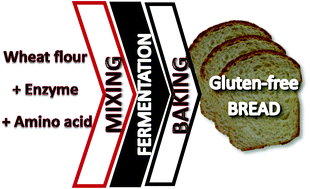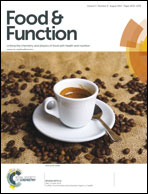Transamidation of gluten proteins during the bread-making process of wheat flour to produce breads with less immunoreactive gluten†
Abstract
Due to an increasing incidence of celiac disease (CD) and other gluten-related disorders, different gluten-free breads have been developed using starches and additives as a substitute for gluten. Thus, patients miss not only the taste and aroma of wheat bread but also risk their sensitive intestines. Therefore, modifying gluten to avoid an immune response in CD and its application to baking is in progress. The aim of the study was to enzymatically modify gluten on wheat flour, during bread-making avoiding the use of additives, to reduce immunoreactivity, preserving its properties. Microbial transglutaminase (mTG) or chymotrypsin (ChT) was used to bind lysine or valine to gluten proteins in a model system. The best conditions were directly applied to wheat flour for bread-making with and without punching at 45 min. Subsequently, the rheological properties of the doughs, specific volume of the loaves, immunoreactive gluten content and modification of the extracted proteins were evaluated. ChT-treated breads presented a better appearance with a more homogeneous crumb, higher specific volume values (3.34–4.25 cm3 g−1) and higher reactive gluten reduction (up to 71%) than the mTG-treated ones (1.23–2.66 cm3 g−1) with only a 42% reactive gluten reduction. Thus, transpeptidation during bread-making is a promising technology, although it is necessary to improve the modification process to obtain the reactive gluten reduction required in breads for the treatment of CD patients and other gluten-related disorders.


 Please wait while we load your content...
Please wait while we load your content...